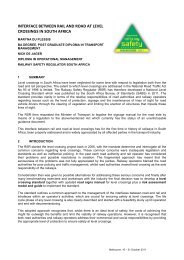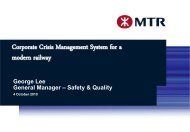successful interface risk management - International Rail Safety ...
successful interface risk management - International Rail Safety ...
successful interface risk management - International Rail Safety ...
You also want an ePaper? Increase the reach of your titles
YUMPU automatically turns print PDFs into web optimized ePapers that Google loves.
Axel Kappeler, James Catmur<br />
Arthur D. Little<br />
Successful <strong>interface</strong> <strong>risk</strong> <strong>management</strong> – from blame culture to joint action<br />
CONCLUSION<br />
Interfaces are important because they are everywhere. However, current approaches for managing safety<br />
<strong>risk</strong>s at <strong>interface</strong>s often only consider technical aspects and whilst some include considerations of manmachine<br />
<strong>interface</strong>s few consider non-technical (e.g. organisational) <strong>interface</strong>s.<br />
This paper proposes a new approach to systematically identifying, assessing and managing non-technical<br />
<strong>interface</strong> <strong>risk</strong>s. The emphasis of the approach is on bringing both parties together to work jointly to manage<br />
the <strong>interface</strong> <strong>risk</strong>s. As a result there is a far better understanding and agreement on:<br />
1. What the <strong>interface</strong> is.<br />
2. What the <strong>risk</strong>s at the <strong>interface</strong> are.<br />
3. How big the <strong>risk</strong>s are.<br />
4. What actions need to be taken by each party to manage each <strong>risk</strong>.<br />
Core to the approach used for identifying <strong>interface</strong> <strong>risk</strong>s is a HAZOP style assessment using Guidewords.<br />
HAZOP is an especially powerful technique for analysing <strong>interface</strong>s. The paper also proposes a framework<br />
for managing the identified <strong>risk</strong>s to make sure they actually reduce <strong>risk</strong> – an area often overlooked or<br />
conducted poorly in many organisations.<br />
The approach outlined in this paper has been applied <strong>successful</strong>ly by a number of clients in the UK and<br />
abroad including a high speed rail project, the Highways Agency and a multinational manufacturing<br />
company.<br />
REFERENCES<br />
[1] http://oxforddictionaries.com/<br />
[2] Department of Defence standard practice system safety, MIL-STD-882E, 11 May 2012<br />
[3] North Atlantic Treaty Organisation, RTO technical report TR-IST-027, Validation, verification and<br />
certification, of embedded systems, published October 2005<br />
[4] Commission Regulation (EC) No 352/2009 of 24 April 2009 on the adoption of a common safety<br />
method on <strong>risk</strong> evaluation and assessment as referred to in Article 6(3)(a) of Directive 2004/49/EC of<br />
the European Parliament and of the Council<br />
[5] NASA Risk <strong>management</strong> handbook pre-decisional first draft, NASA/SP-2011-XXX, Version 1.0, XXXXX<br />
2011<br />
[6] Catmur J, Chudleigh M, Redmill F, System safety: HAZOP and software HAZOP (Hardback, 1999)<br />
[7] Kletz T, Hazop and Hazan – Identifying and assessing process industry hazards, 4 th edition, IChemE,<br />
1999<br />
[8] Chemical Industries Association, A guide to hazard and operability studies, 1990<br />
[9] Kletz T, Hazop and Hazan, Notes on the identification and assessment of hazards, loss prevention, The<br />
Institution of Chemical Engineers Information Exchange Scheme, Hazard workshop modules<br />
London, 8 – 10 October 2012















